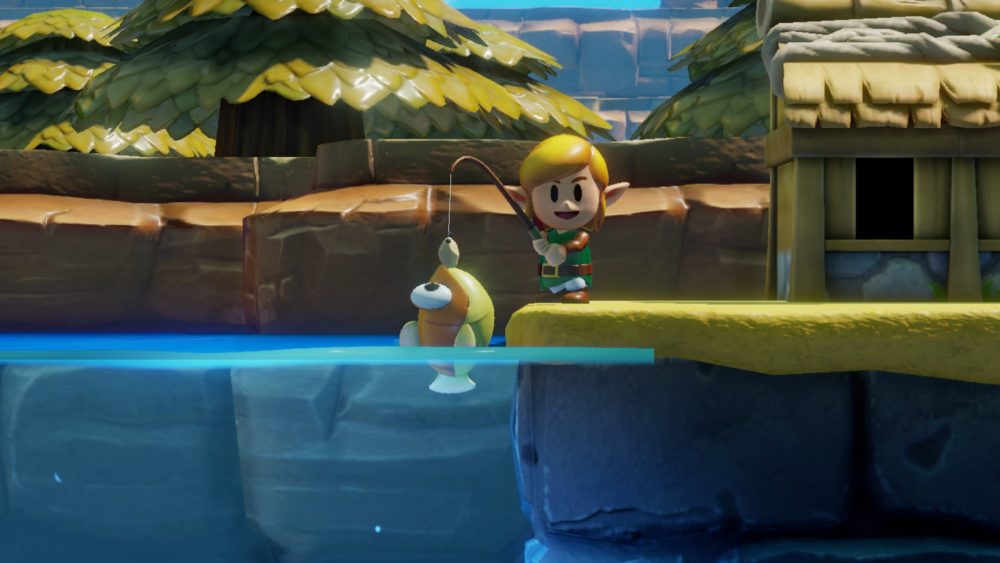
The Legend of Zelda: Link’s Awakening is a remake of the 1993 Game Boy title of the same name. In many ways, Link’s Awakening is an ideal game to remake — because it appeared on a system that many players today would never have owned, and has never been considered a must-play entry in the series, it will be an entirely new game to most.
There are a few things to know about Link’s Awakening prior to jumping in: because it was made for the Game Boy, it’s neither the most complex Zelda game ever made nor the longest. It’s also one of the weirder entries in the series, more tonally in line with Majora’s Mask than it is A Link to the Past. Indeed, story lead Yoshiaki Koizumi has said in the years since the original’s release that he’d been very inspired by the TV show Twin Peaks while breaking the game’s plot. It’s easy to detect Twin Peaks‘ influence on the game even today — Link’s Awakening is fascinated by dreams, both the act of dreaming itself and the malleable inner logic of the dream state.
While its story is open to numerous knotty questions about perception and the subconscious, the gameplay and design of Link’s Awakening is still very much of the Game Boy era. That’s something that feels like it needs to be rammed home, given the sprawling, open-ended state of the series in the modern-day. If you were among the generation of Game Boy owners that played Link’s Awakening in its day, you will find it is almost exactly the same experience — I cross-checked ancient GameFAQs walkthroughs from 2001 while writing this review and they’re still applicable. It’s a simple game, and a pretty small one — its map is small even compared to that of A Link to the Past and microscopic against something like Breath of the Wild. Its puzzles aren’t exactly brain teasers but are mechanically satisfying enough to solve. If you can decipher some of the 26-year-old quest cues, you’ll likely roll through the game’s first couple of dungeons within a few hours and knock the entire game over within 12.
What I suspect will irritate many players is the amount of backtracking each dungeon requires you to do. There’s a lot of back-and-forth in each dungeon, returning to the entrance and branching off in a new direction or doubling back to certain rooms over and over. It was a common design methodology in the early ’90s, an economical (though not terribly fun) way of padding out a game’s total play time. In 2019, it can make exploring dungeons a bit of a dreary affair. Some are worse for it than others, and your mileage will vary depending on your patience for such things.
Link’s Awakening follows the series’ tradition of finding interesting new ways to express itself through its visuals. The game’s entire aesthetic is presented in a style similar to a diaorama, each character looking a bit like a small wooden model. This look perfectly communicates the game’s slightly warped vibe. If there’s a downside at all, it’s that it seems to tax the Switch hardware a great deal, with frequent and significant frame drops. This is pretty surprising, for a couple of reasons. It’s rare to see a first-party Nintendo title release with performance issues of any sort. What’s more, Link’s Awakening, as a package, doesn’t feel like it should be pushing the Switch anywhere near hard enough to cause issues this noticeable. I do hope that it’s something Nintendo can address with future updates but, on the other hand, if these wrinkles were going to be sorted out at all, they probably would have been by now.
The Legend of Zelda: Link’s Awakening is a nice piece of video game history that’s been given the kind of love and attention remakes only sometimes receive. While the performance issues are certainly a blow, it nevertheless ensures that a whole new generation of players gets to experience one of the Zelda franchise’s quirkiest and most memorable titles. I hope Nintendo is looking seriously at updating other wayside classics in a similar manner.
![]()
![]()
![]()
![]()
![]()
FOUR STARS (OUT OF FIVE)
Highlights: Charming visuals; Short and sweet; Old enough to be new to most
Lowlights: Some performance issues; aged design may frustrate players unused to it
Developer: Nintendo
Publisher: Nintendo
Platforms: Nintendo Switch
Available: Now
Review conducted on Nintendo Switch with pre-release code provided by the publisher.
